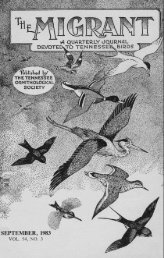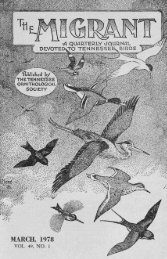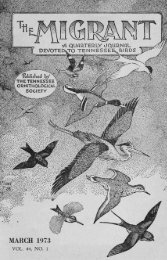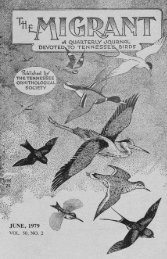Create successful ePaper yourself
Turn your PDF publications into a flip-book with our unique Google optimized e-Paper software.
<strong>1961</strong> THE RITC RANT 49- - - - . . - - - - - - -- . - -Barred. Owls. On the morning of Jun~ 12 thth bird was nowherc to be seen,and subsequent trips were unsucccssfui. We can only deduce, then, thatthe L~mpkin left during thc cvcnlng or n~gklt 01 June 11. Recall~ng thatthe night of Junc 10 was very stormy, ive than perham expla~n why thebird had not left sooner.There are several things about whlck we naturallv wonder. Whcre didthe Limpkin comc from? What caused it to come hcr?? What did it eatwhile it was here? Where did it go? As far as wc can ascertain there wereno great storms In the Southeast which might have forced tt to this area.We can only call it a stray. This is the iirst rccord of a Limpkin in thcstate of Tennessee, and any rccord uf lhls species outsldc its breeding rangein Florida and southernmost Ge<strong>org</strong>~n 1s cxtrerncly rarc. This fact is largelyexplained in that the species is non-migratory.Furbush describes its favorite food a; largp R-csh-water snails. Bent,in Life Histories of Norfh American Marsh Birds. 1926, page 257, states,"The Limpkrn scems to feed mainly on animal food, which 1t f~nds in thcswamps where ~t Ilves, such as various mollusks, r.rust;lceans, frogs, lizards,worms, and aquatic insects." In exarnlnlng this diet we realize that RadnnrLake coulcl easlEy supply several clE ~ts itpms-frogs, llzardu, worms, andaquatic insects. There 1s also a fa~r abundance of peri-winklc snails in thclakc. Dr. Henry Bryant (1861) dcscrrbes ~ts manner of feeding 011 snails."Its mannel. of teedirlg is to hold the silt.11 In ont: of ~ts fect, and then wrtha few blows nf its powcrfui bill to detach thc anamnl, whlch it imrnediatclyswallows." Perhaps the Limpkin iound it puvdble to apply th~s rnethudto rl snail as small as the pcri-wlt~klc.WP SUYUIY wish that the bird 'd~lnd re1nalnt.d sn that. more people couldhave obscrved this vc~ y intcresllng species.RICHARD E. KORLAN, 1603 18th Avc., So., N;~si~villc 12, T~nnessepSNOW RUWTING AT MEMPHIS. - Pough's "Audubon Bird Guide ofSmall Land B~rds of E;~st~rn and Cer~ tral North America" states that"snriwflakes" :Ire cspccially attrac1r.d to the trash which the wind blowslip on lakc and stream shorrbs, and the first arriviils arc found there. Onthe sea coast they fr~quent ~ hdunes, c salt ~nnshcs, and lvindswcpt grass-I;~nds, and the opcn bcach, cvhryre thcby sornc.t~mcs follow the w:lvrs likesandpiptars. The Gumbo-sand shorclinc ol the Mtssiss~ppl River on President's1sl;lnd ;it Memphis, whcre I haw. hvrn uhserv~ng Rlack and Caspian'1"crns. Rilr~apartr's Cull, Golden Plovcrs and v;lr.ious species tlf shorebirdsand waterfowl, has on[,-half milc of short~linti habitat facing nu1 th, bordcredby ;in c~xt~nsivl~ w~llow thickct. Sln:~ll switch wlllows, with thinly scatteredpatches rll 1ot)sc grass, heavily l:idtln with serds, gruwrng beneath, borderthcse and scattt5rtd driftwuod 1s d~posit~d at the top of thc small shelf leftby the receding river. The bearh is nearly fort.v fcct wfdc and has smallrain-washed gul1it.s in Ih? muck and sand to the r~v~r's cdgr at zero stageon thc river gauge. This is the setting lor the advcnturc of discoveringthe first Snow Bunling EPlrctrophenax nivalis) In thc Memphis area. Ihaven't visited this site often In the fall c~f 1960. November 2, 1960 presentedthe only thorough observations made. Thls individual was flushed3s 1 walked between the watrr's c3dgc and willows. I rmrn&iate2y saw







